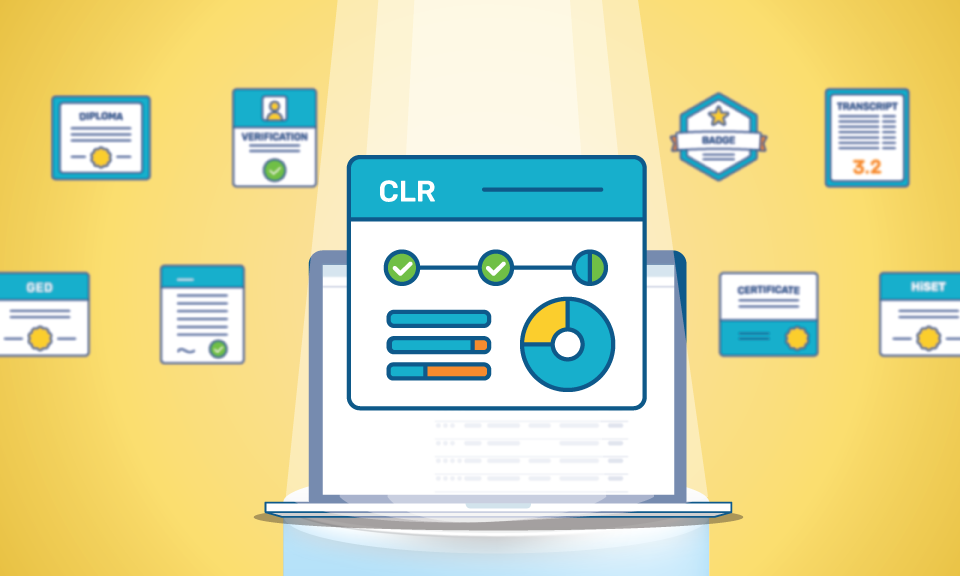
CLR Services
What Higher Ed Leaders Told Us About Skills Communication (and Why It Matters)
Learn how Comprehensive Learner Records help institutions showcase skills, boost employability, and connect education to workforce success.

Today, both learners and institutions are on the lookout for better ways to showcase academic and professional achievements. While traditional credentials like diplomas and transcripts have long been the go-to standards, innovative solutions like Comprehensive Learner Records (CLRs) are stepping up to meet the demand for a more holistic, verified, and shareable representation of learning.
But, what exactly makes a CLR unique? Let’s break it down.
A Comprehensive Learner Record is a dynamic, digital credential that captures a student’s full learning journey at their institution. Unlike traditional credentials, which primarily focus on academic performance, a CLR provides a broader view by including co-curricular activities, skills, competencies, and other achievements. This record is verified by the issuing institution and designed to be easily shareable — whether it’s with employers, other institutions, or different stakeholders.
Think of a CLR as a multidimensional snapshot of a learner’s experience, going beyond grades to highlight leadership roles, certifications, and even soft skills. It offers a clearer picture of what a student brings to the table. And, as a result, organizations like the American Association of Collegiate Registrars and Admissions Officers (AACRAO) are working to expand the understanding and use of CLRs — reflecting concerted efforts to promote these records moving forward.
To understand what makes a CLR unique, let’s explore how it compares to other commonly used credentials:
Digital badges are microcredentials that signify mastery of a specific skill or achievement — often awarded after completing a course or earning a certification. While badges are useful for highlighting discrete accomplishments, a CLR can offer added context. CLRs integrate multiple digital badges alongside other achievements for a more comprehensive narrative of a learner’s capabilities.
Certificates typically recognize a specific program or course completion, serving as proof of competency in a particular area. However, they usually represent a single event or milestone. CLRs, on the other hand, bring together multiple certifications for a richer context of the learner’s entire educational journey.
Traditional transcripts and diplomas are cornerstones of academic documentation — listing courses completed, grades earned, and degrees awarded. While these records remain essential, they primarily focus on academic achievements and provide little insight into extracurricular activities, internships, or skills development. CLRs fill this gap by showcasing a student’s full range of experiences and qualifications, from leadership roles to volunteer work and beyond.
LERs bridge the gap between education and employment by capturing a learner’s full range of skills — including those gained beyond the classroom, like workplace training. This is especially important, as a report from ManpowerGroup reveals that 74% of employers are struggling to find skilled talent today.
While there is overlap with CLRs, the key distinction lies in their focus: CLRs are institution-verified records that document a student’s academic achievements and experiences while enrolled. Everything included is validated by the school, making them a trusted part of a learner’s official credentials. LERs, on the other hand, go a step further, incorporating skills gained on the job and other professional development experiences.
Both tools support career readiness, but CLRs emphasize academic milestones, while LERs paint a broader picture of a learner’s lifelong growth.
Resumes and CVs are self-reported documents that outline an individual’s education, skills, and work experience. While they’re essential for job applications, they rely on the individual’s ability to present themselves effectively — which can sometimes lead to overstatement or omission.
In contrast, CLRs are verified by institutions, lending credibility and authenticity to the information they contain. That way, employers can trust that the data in a CLR is accurate and comprehensive.
Microcredentials have become an increasingly popular way to validate specific skills and competencies. Like digital badges, they represent small, focused achievements. However, without a system like CLRs to tie them together, they risk being viewed in isolation. CLRs integrate microcredentials into a unified record, providing context and demonstrating how these skills contribute to broader educational and professional goals.
Digital wallets are platforms that store different credentials, from digital badges and certificates to transcripts and much more. They’re a convenient way to access and share records, but they don’t inherently offer the narrative or holistic perspective that CLRs provide. A CLR can be housed within a digital wallet, adding value by offering a comprehensive view of the learner’s achievements.
The Parchment Lifelong Learner Account, Parchment’s solution to a digital wallet, stores and manages a learner’s credentials for life. By providing a secure, centralized place to access and share verified achievements, Parchment’s Credential Profile offers a more complete picture of a learner’s journey — so they can seamlessly showcase their academic and professional growth.
What sets CLRs apart is their ability to bring everything together — badges, certificates, microcredentials, transcripts, and diplomas — into a single, comprehensive record. Instead of learners having to track down and present each credential separately, a CLR seamlessly connects the dots to tell a complete, compelling story of their achievements.
This not only helps students showcase their skills more effectively — essentially creating a stronger, more dynamic resume or CV — but also gives educators deeper insights into student outcomes.
For employers and admissions teams, CLRs simplify the process of evaluating candidates by providing a trusted, institution-verified record. They make it easier to identify individuals whose skills and experiences align with organizational or academic goals.
Looking for a way to help students stand out in competitive environments while simplifying the credentialing process? Parchment CLR services empower institutions to create, manage, and share Comprehensive Learner Records with ease. With Parchment, every record is institution-verified, digitally secure, and easily shareable across platforms.
Learn more about Parchment CLR Services or book a demo to get started.
